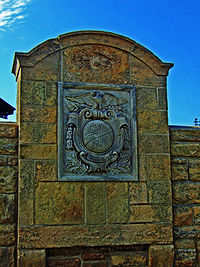
Civil Works Administration
Encyclopedia

New Deal
The New Deal was a series of economic programs implemented in the United States between 1933 and 1936. They were passed by the U.S. Congress during the first term of President Franklin D. Roosevelt. The programs were Roosevelt's responses to the Great Depression, and focused on what historians call...
during the Great Depression
Great Depression
The Great Depression was a severe worldwide economic depression in the decade preceding World War II. The timing of the Great Depression varied across nations, but in most countries it started in about 1929 and lasted until the late 1930s or early 1940s...
to create manual labor jobs for millions of unemployed. The jobs were merely temporary, for the duration of the hard winter. Harry L. Hopkins was put in charge of the organization. President Franklin D. Roosevelt unveiled the CWA on November 8, 1933.
The CWA was a project created under the Federal Emergency Relief Administration
Federal Emergency Relief Administration
Federal Emergency Relief Administration was the new name given by the Roosevelt Administration to the Emergency Relief Administration which President Herbert Hoover had created in 1932...
(FERA). The CWA created construction jobs, mainly improving or constructing buildings and bridges. It ended on March 31, 1934, after spending $200 million a month and giving jobs to 4 million people.
Accomplishments

Alf Landon
Alfred Mossman "Alf" Landon was an American Republican politician, who served as the 26th Governor of Kansas from 1933–1937. He was best known for being the Republican Party's nominee for President of the United States, defeated in a landslide by Franklin D...
, who later ran against Roosevelt in the 1936 election
United States presidential election, 1936
The United States presidential election of 1936 was the most lopsided presidential election in the history of the United States in terms of electoral votes. In terms of the popular vote, it was the third biggest victory since the election of 1820, which was not seriously contested.The election took...
.
Representative of the work are one county's accomplishments in less than five months, from November 1933 to March 1934. Grand Forks County, North Dakota put 2,392 unemployed workers on its payroll at a cost of about $250,000. When the CWA began in eastern North Dakota, it could hire only 480 workers out of 1,500 who registered for jobs. Projects undertaken included work on city utility systems, public buildings, parks, and roads. Rural areas profited, with most labor being directed to roads and community schools. CWA officials gave preference to veterans with dependents, but considerable political favoritism determined which North Dakotans got jobs.
Opposition
Although the CWA provided much employment there were many taxpayers who saw leaves being raked but nothing of permanent value. Roosevelt told his cabinet that this criticism moved him to end the program and replace it with the WPAWorks Progress Administration
The Works Progress Administration was the largest and most ambitious New Deal agency, employing millions of unskilled workers to carry out public works projects, including the construction of public buildings and roads, and operated large arts, drama, media, and literacy projects...
which would have long-term value for the society, in addition to short-term benefits for the unemployed.
Further reading
- Bremer, William W. "Along the "American Way": The New Deal's Work Relief Programs for the Unemployed," Journal of American History Vol. 62, No. 3 (Dec., 1975), pp. 636-652 in JSTOR
- Peters, Charles and Timothy Noah. "Wrong Harry -- Four million jobs in two years? FDR did it in two months" SlateSlate (magazine)Slate is a US-based English language online current affairs and culture magazine created in 1996 by former New Republic editor Michael Kinsley, initially under the ownership of Microsoft as part of MSN. On 21 December 2004 it was purchased by the Washington Post Company...
Jan. 26, 2009 online - Schwartz, Bonnie Fox,. The Civil Works Administration, 1933-1934: The Business of Emergency Employment in the New Deal (1984), a standard scholarly history
- Walker, Forrest A. The Civil Works Administration: an experiment in Federal work relief, 1933-1934 (1979), a standard scholarly history
Primary sources
- McJimsey, George, ed. FDR, Harry Hopkins, and the civil works administration (LexisNexis, 2006) 679 pages; vol 30. of the Documentary History of the Franklin D. Roosevelt Administration
- "Report on Civil Works Administration of Alabama, Jefferson County Division, Nov. 19, 1933 - Mar. 31, 1934" in the Birmingham Public Library's Digital Collections
External links
- Remarks on Signing Executive Order Creating Civil Works Administration
- Four million jobs in two years? FDR did it in two months.
- 1934: A New Deal for Artists" is an exhibition on the artists of the Great Depression at the Smithsonian American Art Museum
- University of Washington Libraries Digital Collections – Civil Works Administration Photographs 119 images showing work projects in King County, Washington established under the auspices of the Civil Works Administration in 1933-34.

